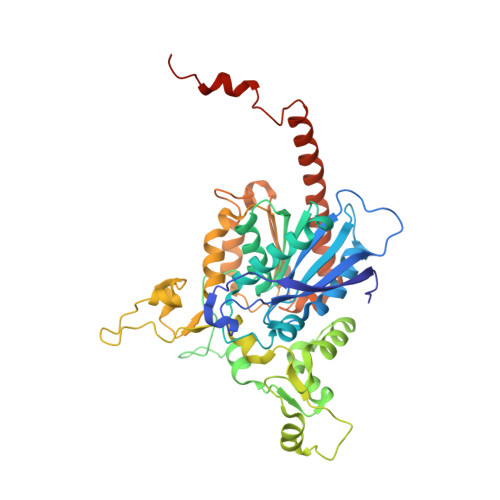Structural basis for substrate specificity of the peroxisomal acyl-CoA hydrolase MpaH' involved in mycophenolic acid biosynthesis.
You, C., Li, F., Zhang, X., Ma, L., Zhang, Y.Z., Zhang, W., Li, S.(2021) FEBS J 288: 5768-5780
- PubMed: 33843134
- DOI: https://doi.org/10.1111/febs.15874
- Primary Citation of Related Structures:
7DBI, 7DBL - PubMed Abstract:
Mycophenolic acid (MPA) is a fungal natural product and first-line immunosuppressive drug for organ transplantations and autoimmune diseases. In the compartmentalized biosynthesis of MPA, the acyl-coenzyme A (CoA) hydrolase MpaH' located in peroxisomes catalyzes the highly specific hydrolysis of MPA-CoA to produce the final product MPA. The strict substrate specificity of MpaH' not only averts undesired hydrolysis of various cellular acyl-CoAs, but also prevents MPA-CoA from further peroxisomal ¦Â-oxidation catabolism. To elucidate the structural basis for this important property, in this study, we solve the crystal structures of the substrate-free form of MpaH' and the MpaH' S139A mutant in complex with the product MPA. The MpaH' structure reveals a canonical ¦Á/¦Â-hydrolase fold with an unusually large cap domain and a rare location of the acidic residue D163 of catalytic triad after strand ¦Â6. MpaH' also forms an atypical dimer with the unique C-terminal helices ¦Á13 and ¦Á14 arming the cap domain of the other protomer and indirectly participating in the substrate binding. With these characteristics, we propose that MpaH' and its homologs form a new subfamily of ¦Á/¦Â hydrolase fold protein. The crystal structure of MpaH' S139A /MPA complex and the modeled structure of MpaH'/MPA-CoA, together with the structure-guided mutagenesis analysis and isothermal titration calorimetry (ITC) measurements, provide important mechanistic insights into the high substrate specificity of MpaH'.
Organizational Affiliation:
State Key Laboratory of Microbial Technology, Shandong University, Qingdao, China.

















